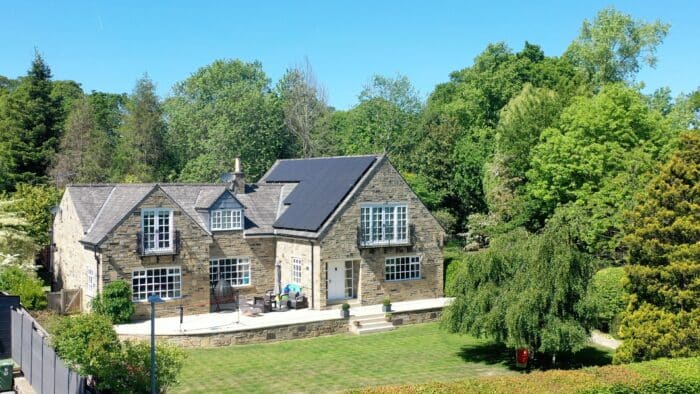The UK’s energy landscape is changing fast and with it, the way we power and pay for our homes.
By 2030, millions more homes are expected to install solar, and the national grid will be cleaner and smarter. But energy won’t necessarily be cheaper. In fact, households that rely solely on the grid could see significant cost increases, while solar-powered homes stand to gain energy independence, long-term affordability, and a valuable financial buffer.
Let’s break down what energy bills could realistically look like by 2030, both with and without solar.

A Look Back at The Energy Price Rollercoaster
To understand where we’re going, it helps to look at where we’ve been.
| Year | Ofgem Price Cap (typical dual fuel home) |
|---|---|
| 2020 | ~£1,042/year |
| 2022 | Peaked at £4,279/year |
| 2023 | Dropped to £2,074 (July) |
| 2024 | Stabilised at £1,690–£1,928 (as of July) |
Although prices have cooled from the 2022 spike, they remain 70–85% higher than pre-crisis levels. And while Ofgem adjusts the cap quarterly, wholesale volatility, geopolitical risk, and infrastructure investment mean we’re unlikely to return to “cheap” energy anytime soon.
2030 Price Forecasts What Experts Predict
While future pricing depends on many variables (including global gas demand, green levies, and UK energy policy), here’s what key sources suggest:
- National Grid Future Energy Scenarios expect average bills to remain above £1,800/year throughout the 2020s.
- Cornwall Insight forecasts £1,917/year average bills in 2025, with only modest reductions by 2030.
- Energy UK suggests long-term prices will reflect the cost of upgrading to a greener, smarter grid, keeping bills high even as fossil fuels decline.
Solar in 2030, The Homeowner Advantage
Installing solar is no longer just about being green, it’s about beating the market. Let’s compare what life could look like for two typical households in 2030:
🏠 Scenario A: Grid-Only Home
- Pays full unit price for electricity (projected 2030: 32–36p/kWh)
- Annual usage: 3,800 kWh
- Estimated bill: £1,216–£1,368/year
- Exposed to ongoing price volatility
- Pays more during peak evening hours
☀️ Scenario B: Solar Home (5kW system + 5kWh battery)
- Generates 4,000–4,500 kWh/year
- Self-consumes 70–85% with battery
- Only buys top-up energy at night
- Estimated bill: £200–£450/year
- Additional savings via SEG export payments
- Enjoys price stability for 20–25 years
Over a decade, that’s a difference of £8,000–£11,000 saved, not including government incentives, export income, or rising grid rates.
Why Solar Keeps Saving More Over Time
🔋 Battery Storage Makes a Big Difference
Pairing solar with a battery boosts your self-use rate dramatically – from 35% to 75% or more. That means more free energy, less reliance on the grid, and far fewer nasty surprises on your bill.
🧠 Smart Tariffs + Solar = Bigger Gains
By 2030, more suppliers will offer time-of-use tariffs. Solar homeowners with battery storage can charge/discharge strategically, buy cheap overnight top-ups, and sell back power at peak times – creating mini virtual power plants at household level.
🧾 The Solar Payback Gets Faster
With average bills expected to remain high, the payback period for a typical solar system is shrinking. In 2024, it’s around 6–8 years. By 2030, some homes could break even in just 4–6 years due to rising energy rates.
💰 Cost Comparison: 2030 Energy Spend Over 10 Years
| Time Period | Grid-Only Home | Solar Home (with battery) |
|---|---|---|
| 2025–2030 | ~£7,500 | ~£1,800 |
| 2025–2035 | ~£15,000 | ~£4,000 |
| Lifetime (25 yrs) | £35,000+ | £8,000–£10,000 |
That’s £25,000+ saved over the lifetime of a solar system, and a lot less stress over price hikes.
🌎 And Don’t Forget the Bigger Picture
Even beyond the financials, installing solar future-proofs your home:
- ✔️ Better EPC rating (essential for landlords by 2028)
- ✔️ Lower carbon footprint
- ✔️ Higher resale value
- ✔️ Backup power options (if combined with a gateway)
- ✔️ Peace of mind
The Sooner You Start, The More You Save
If your home is suitable for solar, waiting until 2030 means missing out on thousands of pounds of savings in the meantime. And as demand rises, installation lead times and prices may increase.
A 2025 install locks in today’s costs, and gives you a head start on building long-term resilience against an uncertain energy future.
Want a Quote for Your Home?
We’ll show you exactly what you could save over the next 5, 10 or 25 years, based on your property, roof, usage and location. No pushy sales. Just clear advice and real numbers.